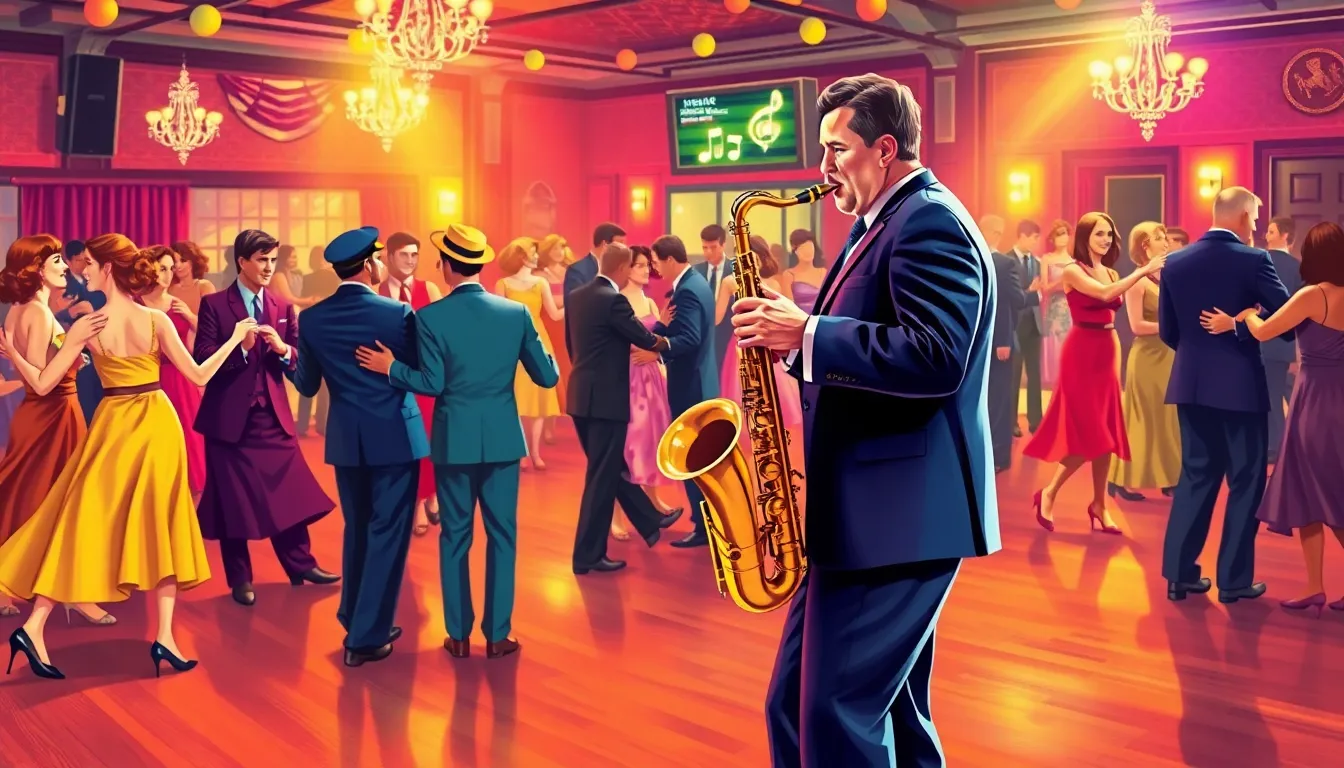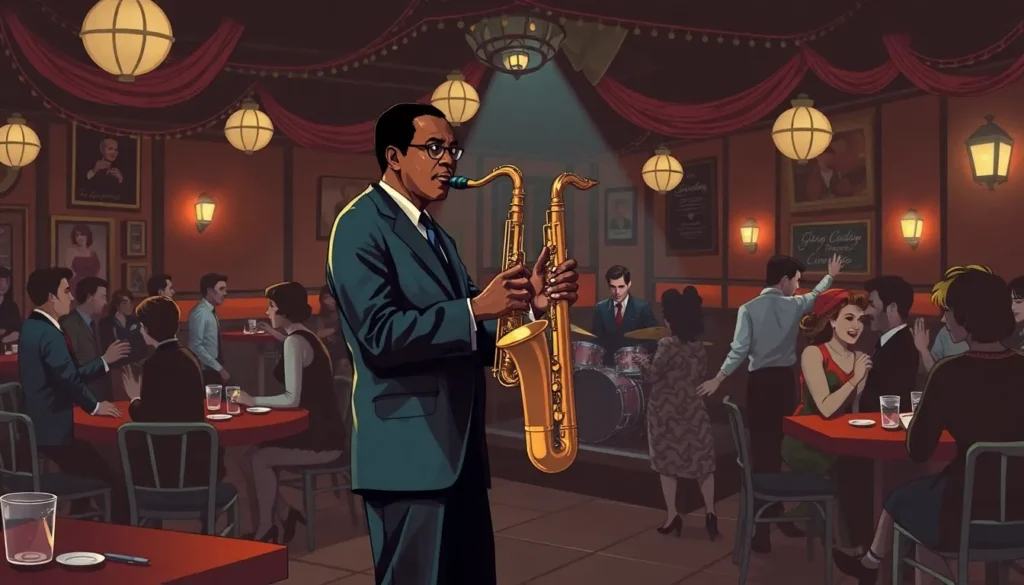The 1940s was a decade like no other, bursting with vibrant pop culture that shaped the world in ways still felt today. Picture this: jazz clubs filled with the sounds of big bands, Hollywood churning out films that whisked audiences away from the harsh realities of war, and fashion that turned sidewalks into runways. It was a time when swing dancing was a national pastime and radio shows were the Netflix of their day.
Table of Contents
ToggleOverview of 1940s Pop Culture
The 1940s showcased diverse elements that shaped American pop culture. Jazz clubs thrived, providing vibrant spaces for musical innovation and social interaction. Swing music dominated the scene, encouraging energetic dance styles like the jitterbug and Lindy hop. Hollywood films captivated audiences, offering escapism through genres such as film noir, musicals, and war dramas. Iconic figures like Humphrey Bogart and Rita Hayworth emerged, leaving a lasting impact on the industry.
Fashion trends also played a vital role during this decade. Women’s attire reflected both practicality and elegance, with dresses featuring cinched waists and bold patterns. Men favored sharp suits, often accessorized with fedoras, signaling a shift towards modern masculinity. Each street turned into a runway, as people adorned themselves with these emerging styles.
Radiothon shows provided entertainment, reaching millions across the nation. Shows like “The Jack Benny Program” and “Fibber McGee and Molly” became staples in American households. Along with this, serialized dramas kept listeners engaged with captivating storylines. Newspapers and magazines featured radio listings prominently, as the medium became a crucial source of information and leisure.
Comic books gained immense popularity among younger audiences, introducing iconic superheroes like Captain America and Batman. These characters embodied the values of resilience and courage, offering hope during challenging times. Thus, the 1940s highlighted a vibrant pop culture landscape, blending music, film, fashion, and emerging media in ways that transformed American society.
Music Trends of the 1940s

The 1940s marked a dynamic period in music, characterized by significant trends and innovations that shaped the decade’s sound.
Big Band and Swing Music
Swing music reigned supreme during the 1940s, driving the lively atmosphere of dance halls. Big bands emerged as dominant forces, featuring orchestras led by influential musicians like Duke Ellington and Count Basie. Jazz musicians joined forces, creating intricate arrangements that allowed improvisation and creativity to flourish. Energetic dance styles, such as the jitterbug, captivated audiences, bringing people together on crowded dance floors. Popular songs like “In the Mood” by Glenn Miller became timeless classics, leading to a broader embrace of swing. The genre’s spirited rhythm provided an escape from the difficulties of wartime, making it a vital aspect of American culture.
The Rise of Crooners
Crooners gained prominence in the 1940s, bringing a new vocal style that resonated with the public. Artists like Bing Crosby and Frank Sinatra captivated listeners with smooth, emotive performances. Their ability to convey intimacy through music connected deeply with audiences, especially amid the era’s uncertainty. Emphasizing personal narratives, crooners made ballads feel relatable. Songs like “White Christmas” showcased the ability of crooners to convey nostalgia and longing. The combination of heartfelt lyrics and rich melodies made their music a staple on radio shows, further solidifying their influence on popular culture.
Film and Cinema in the 1940s
The 1940s marked a transformative period for film and cinema, characterized by diverse genres and memorable performances. Audiences sought escapism through riveting stories and star-studded casts.
Iconic Movies of the Decade
Notable films from this era include “Casablanca,” which became a defining romantic drama featuring the famous quote “Here’s looking at you, kid.” “Bambi,” released by Disney in 1942, captivated younger viewers with its stunning animation and heartfelt narrative. Other influential titles like “It’s a Wonderful Life” and “The Best Years of Our Lives” explored themes of love and hardship, resonating with audiences amidst global turmoil. Additionally, film noir gained traction, exemplified by “Double Indemnity,” showcasing moral ambiguity and complex characters. Each movie contributed to the rich cinematic tapestry of the decade.
Influential Directors and Actors
Directors like Alfred Hitchcock and John Ford emerged as visionaries. Hitchcock’s suspenseful storytelling in “Rebecca” and Ford’s powerful narratives in “The Grapes of Wrath” defined their unique cinematic styles. Actors such as Humphrey Bogart and Rita Hayworth shaped the landscape of film. Bogart’s portrayal in “The Maltese Falcon” became iconic for its gritty realism. Hayworth, with her dazzling performances in “Gilda,” exemplified the glamor of Hollywood. This blend of directorial talent and star power left an indelible mark on the film industry, making the 1940s unforgettable.
Literature and Arts in the 1940s
The 1940s witnessed significant developments in literature and arts, reflecting societal change during a tumultuous decade. Prominent authors and artists emerged, creating works that captured the national mood and addressed pressing issues.
Prominent Authors and Works
James Baldwin’s “Go Tell It on the Mountain” resonated deeply, exploring themes of identity and spirituality. Catcher in the Rye by J.D. Salinger introduced a new voice of teenage disillusionment that captivated readers. Meanwhile, Ray Bradbury began to develop his unique style, paving the way for future science fiction masterpieces. Margaret Atwood’s works began gaining attention, with insights into human behavior and ethics. Poetry also flourished with figures like Elizabeth Bishop and Robert Lowell, who provided personal and national reflections. These authors shaped American literature, offering diverse perspectives on life during wartime.
The Impact of War on Art
World War II profoundly impacted art movements across the United States. Artists like Jackson Pollock and Mark Rothko embraced abstract expressionism, reflecting the chaos and emotions of the time. The trauma of war fueled creativity and fueled a desire for emotional expression. Photographers such as Dorothea Lange captured stark realities, revealing the struggles faced by families during the Great Depression and wartime. Art became a medium for social commentary, prompting discussions on morality and resilience. The urgency of the period inspired innovative techniques and styles that left a lasting legacy, shaping the trajectory of modern art.
Fashion and Style of the 1940s
The 1940s marked a distinctive era in fashion, blending practicality with elegance in response to societal changes. Style embraced a silhouette that showcased femininity and sophistication.
Key Fashion Trends
Women’s dresses featured cinched waists and full skirts, often adorned with bold patterns, while shoulder pads and tailored suits defined men’s wardrobes. The marriage of style with utility was crucial, reflected in the use of fabrics like rayon during wartime rationing. Accessories such as hats and gloves became essential for both genders, adding flair to outfits. The popularity of high-heeled shoes for women contrasted with men’s classic footwear, which typically included Oxfords and brogues. Swimwear also evolved, highlighted by the introduction of two-piece bathing suits that emerged as symbols of liberation. Additionally, casual wear gained traction, with items like bomber jackets and denim jeans becoming staples in American closets.
Influential Designers
Notable designers greatly influenced 1940s fashion trends. Christian Dior’s “New Look,” introduced in 1947, revolutionized women’s clothing with voluminous skirts and emphasized hourglass silhouettes. Coco Chanel redefined elegance with her classic suits and the little black dress, championing simplicity and chicness. Other impactful figures included Claire McCardell, who popularized practical styles that embraced comfort, and Elsa Schiaparelli, known for her bold experimentation with color and surrealism. Significant fashion houses emerged, establishing a foundation for modern luxury. These designers responded to contemporary needs while creatively expressing individuality, firmly establishing their legacies within pop culture.
The 1940s stand as a pivotal decade in the evolution of American pop culture. Its vibrant music scene, captivating films, and innovative fashion left a lasting imprint that continues to resonate today. The era’s ability to blend entertainment with social commentary provided a unique escape during challenging times.
From the lively rhythms of jazz to the emotional depth of classic films, the 1940s shaped cultural expressions that reflect resilience and creativity. As modern audiences revisit this remarkable decade, they uncover the roots of contemporary trends and the enduring spirit of a time that embraced change and innovation. The legacy of the 1940s remains a testament to the power of art in shaping societal narratives.




